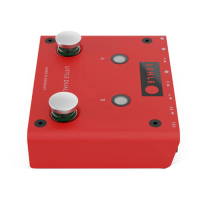5
1. Input socket
Connect your instrument or the output from an
effect unit or DAW here.
The mono input signal is fed into this socket;
should the input socket (2) be used as well this
signal will be routed to output B only.
2. Input socket for a 2
nd
signal
Connect the 2
nd
pickup of your instrument or the
2
nd
stereo output from an effect unit or DAW here.
The signal from this input socket is routed to
output A only. Stereo signals such as the signals
from different pickups can be switched individually
to the outputs A and B, which could be 2 separate
amplifiers or PA channels.
3. B-Output
Connect your amplifier or the input of a mixing
desk here.
The signal is routed to output B directly via a
goldplated switch with no semiconductors. The
Lehle Little Dual, and therefore the instrument
connected, is grounded via this socket. This output
should therefore always be occupied.
4. Phase inverter switch
The phase of the input signal from the A output
can be inverted if necessary.
This switch can be used to invert the phase of the
input signal from the A output socket by 180°.
Splitting signals to two amps may sometimes
cause phase cancellations, resulting, for most
musicians, in a “thin” sound. Inverting the phase
eliminates this problem. Experiment to find out
which position you prefer - as always, your indivi-
dual taste is what counts!
5. A-Output
Connect your amplifier or the input of a mixing
desk here.
Output A is electrically isolated from output B by
the Lehle LTHZ high-end transformer - so hum
loops are impossible, even if A and B are switched
on simultaneously.
A balanced or an unbalanced signal is possible,
irrespective of the type of signal fed from the
input, this way you can connect any guitar or
bass amp as well as balanced inputs on a mixing
console.

